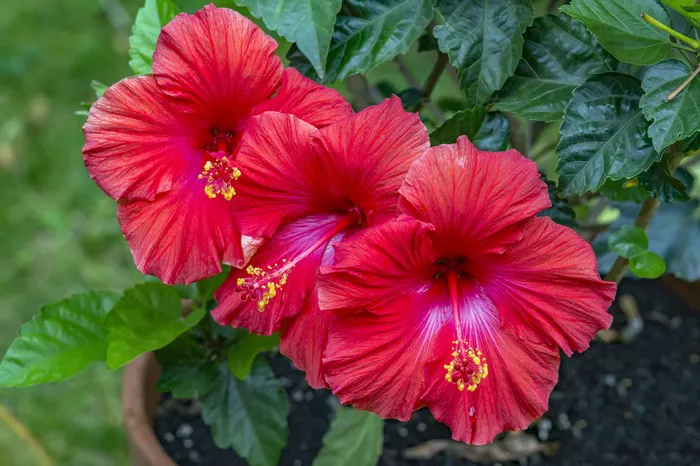Hibiscus plants are cherished for their vibrant blooms and lush foliage, making them a popular choice for gardens, landscapes, and indoor spaces. However, it can be disheartening when your hibiscus fails to produce flowers despite your best efforts. Several factors can contribute to this issue, ranging from environmental conditions to cultural practices. Understanding these factors is essential for troubleshooting and revitalizing your hibiscus’s blooming potential. In this comprehensive guide, we’ll explore the common causes of non-flowering hibiscus plants, offer practical solutions, and provide caring tips to ensure your plant thrives and blooms abundantly.
Understanding the Common Causes
Before diving into solutions, it’s crucial to identify potential reasons why your hibiscus is not flowering. Here are some common culprits:
Insufficient Sunlight: Hibiscus plants thrive in full sunlight, requiring at least six hours of direct sunlight daily to produce blooms. If your hibiscus is not receiving adequate sunlight, it may prioritize foliage growth over flower production.
Improper Pruning: Pruning is essential for shaping and maintaining the health of your hibiscus plant. However, improper pruning techniques or timing can hinder flower development. Over-pruning or pruning at the wrong time of year can remove flower buds or disrupt the plant’s natural blooming cycle.
Nutrient Deficiencies: Hibiscus plants require specific nutrients, particularly phosphorus, to support flower formation. A deficiency in essential nutrients can inhibit blooming. Common deficiencies include phosphorus, potassium, and magnesium.
Watering Issues: Both overwatering and underwatering can negatively impact hibiscus flower production. Overwatering can lead to root rot and nutrient leaching, while underwatering can cause stress and hinder flower development.
Temperature Stress: Extreme temperatures, whether too hot or too cold, can stress hibiscus plants and affect their ability to flower. Sudden temperature fluctuations, especially during budding or flowering stages, can cause bud drop or flower abortion.
Pest and Disease Infestations: Pests such as aphids, whiteflies, and spider mites can damage hibiscus plants, leading to reduced blooming. Additionally, fungal diseases like powdery mildew and leaf spot can weaken the plant and impede flower production.
Rootbound Conditions: When hibiscus plants outgrow their containers or planting beds, they can become rootbound, restricting root growth and nutrient uptake. Rootbound plants may exhibit stunted growth and decreased flowering.
Inadequate Pollination: While hibiscus plants are capable of self-pollination, they may benefit from pollinators such as bees and butterflies. A lack of pollinators in the area can result in poor fruit set and reduced flower production.
Now that we’ve identified the potential causes of non-flowering hibiscus plants, let’s explore effective solutions and caring tips to encourage blooming.
Solutions and Caring Tips
Provide Adequate Sunlight: Ensure your hibiscus plant receives ample sunlight by placing it in a location with at least six hours of direct sunlight daily. If growing indoors, position the plant near a south or west-facing window to maximize sunlight exposure.
Prune Correctly: Practice proper pruning techniques to encourage flower production. Remove dead or diseased branches, as well as any crossing or crowded stems. Avoid excessive pruning during the budding or flowering season to prevent bud loss.
Address Nutrient Deficiencies: Conduct a soil test to identify any nutrient deficiencies and amend the soil accordingly. Fertilize your hibiscus plant regularly with a balanced fertilizer formulated for flowering plants, ensuring it contains sufficient phosphorus for bloom development.
Water Wisely: Maintain consistent soil moisture by watering your hibiscus plant deeply but infrequently. Allow the soil to dry slightly between waterings to prevent waterlogged conditions. Use a well-draining potting mix to promote healthy root growth.
Protect from Temperature Extremes: Shield your hibiscus plant from extreme temperatures by providing adequate insulation during cold weather and shade during hot summer days. Consider moving potted hibiscus plants indoors during frosty nights or scorching heatwaves.
Manage Pest and Disease Issues: Monitor your hibiscus plant regularly for signs of pest infestations or disease symptoms. Treat any problems promptly using organic or chemical control methods, ensuring to follow label instructions carefully to avoid harming beneficial insects or pollinators.
Repot if Rootbound: If your hibiscus plant is rootbound, transplant it into a larger container or repot it into a spacious planting bed. Gently tease apart the roots and prune any circling roots before replanting. Provide adequate water and nutrients to support root establishment and new growth.
Encourage Pollination: Attract pollinators to your garden by planting a variety of nectar-rich flowers alongside your hibiscus plant. Avoid using pesticides that may harm bees and other pollinators. Alternatively, hand-pollinate your hibiscus flowers using a small paintbrush to transfer pollen between blooms.
Conclusion
By addressing these common issues and implementing the suggested solutions and caring tips, you can revitalize your hibiscus plant and encourage abundant flowering. With proper care and attention, your hibiscus plant will reward you with a stunning display of colorful blooms, enhancing the beauty of your garden or indoor space.


